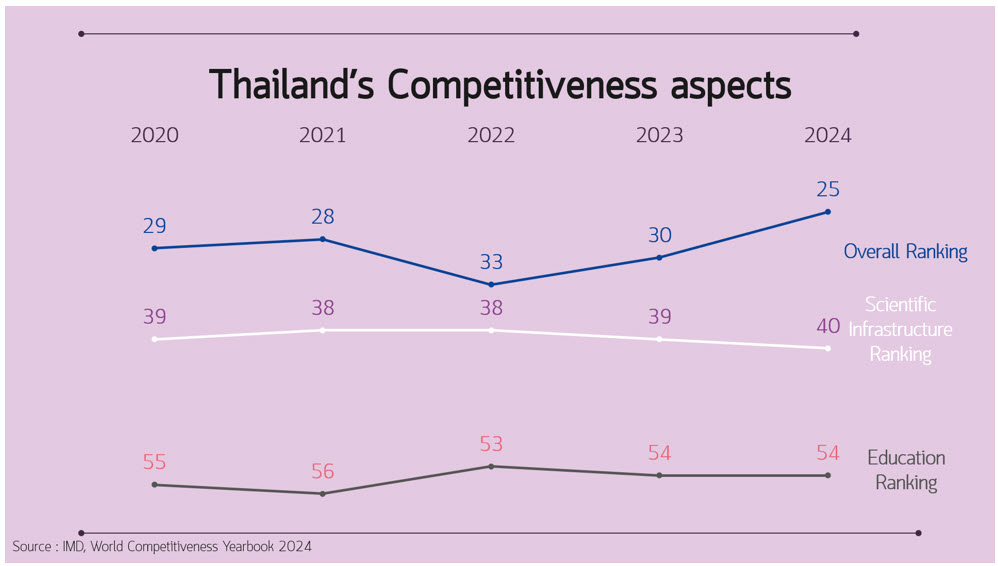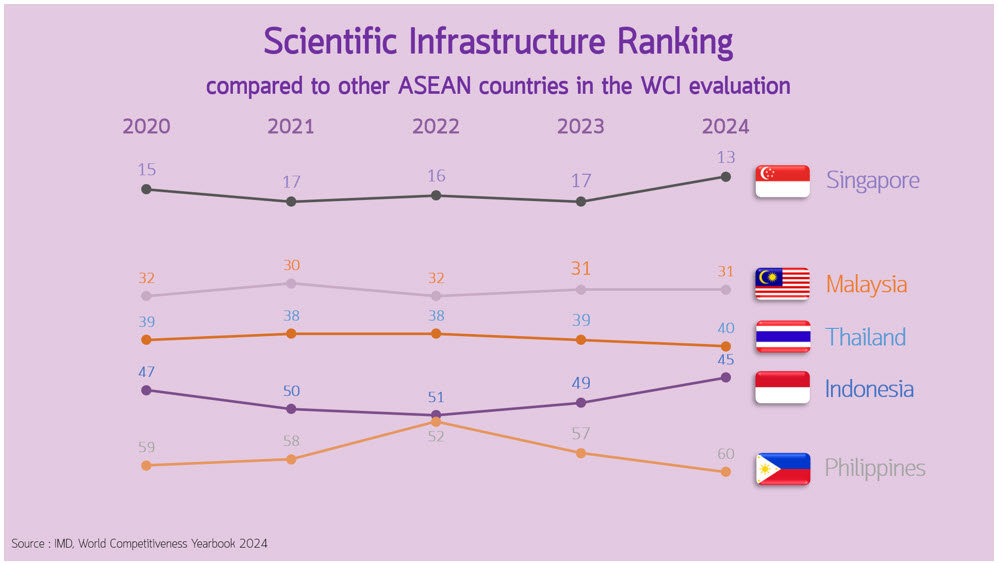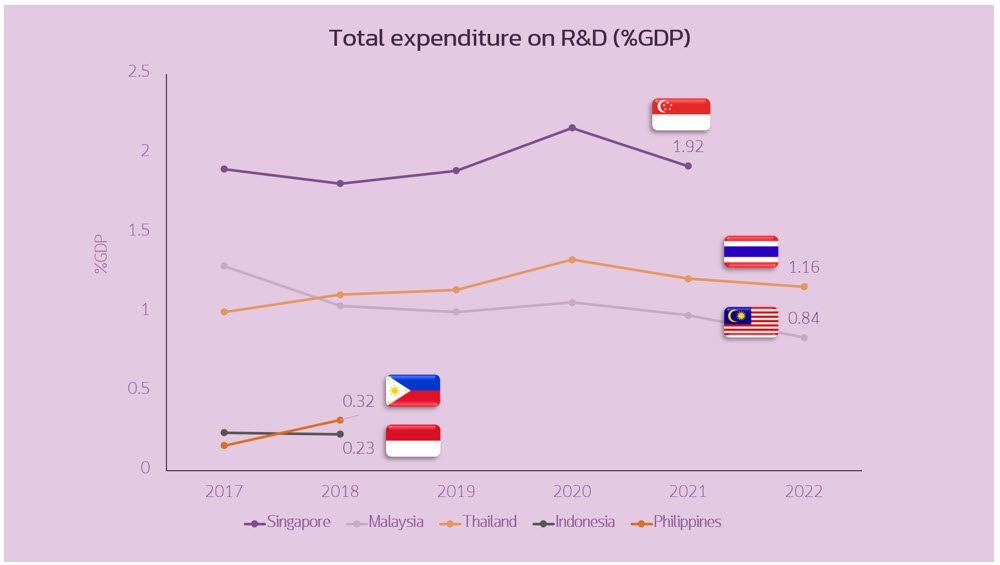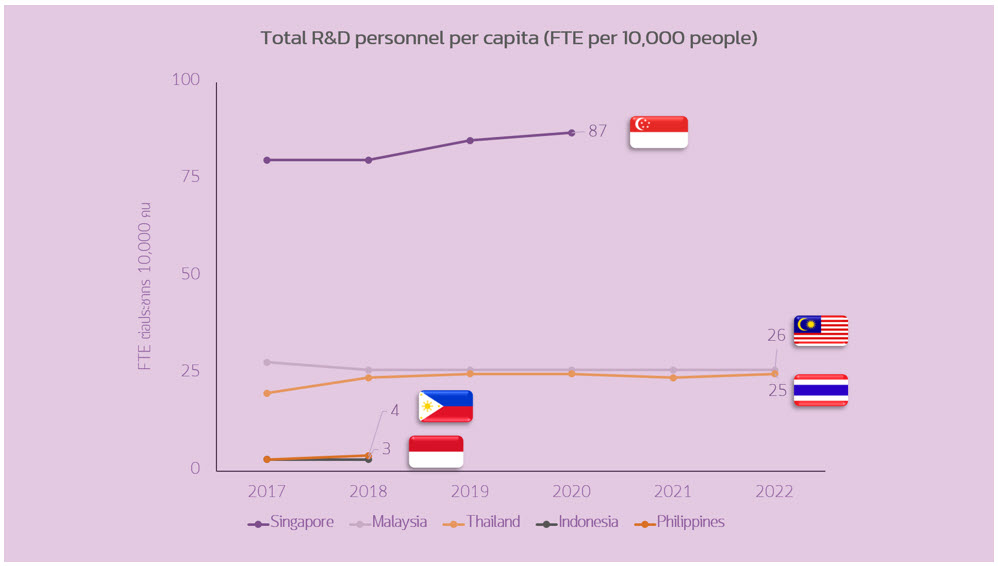According to the rankings of the World Competitiveness Yearbook 2024 by the International Institute for Management Development (IMD), Thailand ranks 25th out of 67 countries evaluated. This has been an improvement from its previous year’s rank at 30th in 2023. Overall, Thailand is ranked second place amongst examined ASEAN countries for the total score in this year (Singapore at 1st place, Indonesia at 27th place, Malaysia at 34st place, and the Philippines at 52nd place).
In the evaluation, competitiveness is measured and ranked in various aspects – including scientific infrastructure and education. In this regard, at any rate, Thailand’s Scientific Infrastructure ranking fell from 39th place in 2023, to 40th place in the latest evaluation of 2024. Noteworthily, Thailand has been rather stable in its rankings in this category, having been placed at 39th place (2020), 38th places (2021 & 2022), then 39th place again in 2023 and fell to 40th place in the current ranking. This does not mean, however, that Thailand has no development, but the downward changes in the ranking comparison is likely the result of other countries in the ranking accelerating themselves in greater quotients.

Taking a look at the components, the dimensions of Scientific Infrastructure (40th, 2024) and Education (54th, 2024) are lagging behind other dimensions, most of which are excelling. On the indicator level, we observe that the main points of concern for Thailand are patents and intellectual property rights utilization, and total R&D expenditure per capita & research personnel per capita. Noteworthily, thailand has a sizeable pool of R&D expenditures and decent human capital stock, but in per capita terms – when divided by the total population of the country, the figures are diluted when taking into account the rather large population size.
In fact, most of the indicators in this dimension that Thailand experiences low ranking are in per capita terms, while absolute value indicators are not ranked as low. This suggests that while Thailand has potential and non-dismissible stocks of input for STI development, they remain rather congested and not always disseminated into the society at large, reflecting the inequality issue – not all groups of people or regions in the country are benefiting fully from scientific capital stock, nor being able to utilize them on a widespread scale and scope. This is an area of challenge that Thailand is working on to address and improve.

Looking at the cross-country comparison in ASEAN, it can be seen that the Scientific Infrastructure Ranking of ASEAN countries can be fairly stable across the years. Singapore’s ranking in this dimension has fluctuated thinly at around the 15th position during the past 5 years, while Malaysia has been stably located between the 30th-32nd places. This suggests that countries may have their structural or time-invariant characteristics that are ‘resistant to time’ and require rigorous change to alter. Nevertheless, Indonesia and the Philippines exhibit sharp changes in the rankings on Scientific Infrastructure – Indonesia has moved up from 51st place in 2022 to 45th place in 2024, while the Philippines has declined in rank from 52nd place in 2022 to 60th place in the most recent evaluation for 2024.

In terms of education, Thailand is ranked at 54th place amongst 67 countries surveyed and evaluated. However, with the exception of Singapore, the ASEAN countries examined in the WCI are ranked similarly to one another, with Malaysia faring slightly better than Thailand, Indonesia and the Philippines. Singapore is an outlier amongst ASEAN countries and has reclaimed a high place at 3rd place out of the 67 countries, a rebound from 2023’s 11th place.
Taking a look at the individual indicators for 2024, there are causes of concern for Thailand’s educational system, particularly in school levels. Thailand is ranked low (over 50th place) in items such as pupil-to-teacher ratio in secondary schools (61st), English proficiency for TOEFL (57th) and overall language proficiency (54th), total public expenditure on education per capita (56th) and per student (52nd), PISA score attainments (54th), student mobility – inbound (54th) and outbound (56th), and, surprisingly, illiteracy rate (59th). These will be the key challenges that Thailand will consider and tackle, since the schooling system and its inputs will significantly affect the capacity of higher education and science, technology and innovation advancements.

In terms of Total Expenditure on R&D (as percentage of GDP), Thailand ranks in the middle of the evaluation, above other ASEAN countries in this survey, excluding, of course, Singapore. Total R&D as percentage of GDP in Thailand fluctuates mildly slightly above the 1% level. Nevertheless, despite relatively good standing within the more advanced ASEAN economies, there is still room for improvement for both Thailand and other fellow ASEAN countries.

In terms of total R&D personnel per capita (measured in full-time equivalents: FTE), Thailand fares better than the Philippines and Indonesia, and on par with Malaysia, at approximately 25 FTE R&D personnel per 10,000 people. However, at 45th place in the evaluation out of 67 countries, this level is still considered to be low by international comparison. Singapore, one of the leading countries in IMD’s World Competitiveness Indicators and 2024’s overall top performer, has total FTE R&D personnel at approximately 87 persons per 10,000 people. On a seemingly unrelated note, this subtly reflects the outputs of the education system which may need to be enhanced, especially in schools, and the need to empower and encourage STEM education and jobs in the economy. One proposed course of action recommended by experts is to match students’ education with their actual job prospects, thus guaranteeing the viability of new graduates in finding work and securing STEM jobs in productive activities.
Looking at the indicators and evaluation results, one can get a grasp of the overall situation on scientific infrastructure and education in Thailand, which are reflected in the statistics and ranking values. We are able to benefit from these insights, as knowing the strong and weaker points of the country can help in designing policy interventions and strategies to address them in the future.


